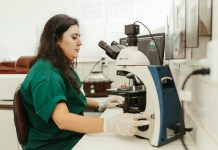
In a new study, researchers found a protein found commonly in human blood might help with the detection of hard-to-diagnose pancreatic tumors.
They developed an approach using the protein’s structure and its function as a proxy for this.
The researchers also showed how its method can also be used to differentiate between benign and malignant tumors.
The research was conducted by a team at Martin Luther University Halle-Wittenberg (MLU) and elsewhere.
Pancreatic cancer is particularly insidious. It remains asymptomatic for a long time, which leads to very late diagnoses and therefore a low chance of treating it successfully.
Nine out of ten patients succumb to the disease within five years after being initially diagnosed.
At the same time, it is very difficult to distinguish between benign and malignant pancreatic tumors.
The only utilizable lab test is inconclusive as it can also be an indication, for example, of a chronically inflamed pancreas.
Even imaging techniques and tissue analyses often do not provide a clear differentiation between benign and malignant tumors to be made.
In the study, the team looked for a biomarker in human blood that could act as a kind of early warning system.
They chose the protein albumin, which occurs in large quantities in the blood.
Different tumors are known to alter the way it functions in the body in different ways. One of albumin’s jobs is to transport fatty acids into the cells.
Since a protein’s spatial structure determines the way it works, the researchers hypothesized that it should be possible to detect small structural changes in the protein in ill patients.
The team examined the blood serum of people with a benign or malignant pancreatic tumor and, for comparison, also samples from healthy people. Nearly 80 samples were analyzed.
The researchers were able to identify specific differences between the individual patient groups.
The spacing patterns and the local environment of the fatty acids were somewhat different in the patients with cancer than in those with a benign tumor as well as in the healthy patients.
The underlying mechanism of how the tumor changes the structure of albumin remains elusive.
The team says this is a promising approach to detect pancreatic cancer early and it needs to be tested on larger samples and to be refined further.
One author of the study is Dr. Marcos Gelos.
The study is published in ACS Pharmacology & Translational Science.
Copyright © 2021 Knowridge Science Report. All rights reserved.



